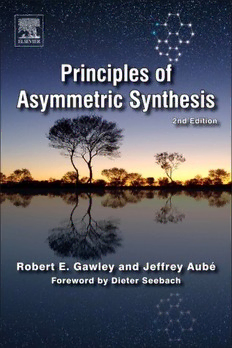Table Of ContentPrinciples of Asymmetric Synthesis
This pageintentionallyleftblank
Principles of
Asymmetric Synthesis
Second Edition
Robert E. Gawley
Department ofChemistry and Biochemistry
Universityof Arkansas
Fayetteville, AR
USA
and
Jeffrey Aube´
DepartmentofMedicinal Chemistry
Universityof Kansas
Lawrence, KS
USA
AMSTERDAM(cid:129)BOSTON(cid:129)HEIDELBERG(cid:129)LONDON(cid:129)NEWYORK(cid:129)OXFORD
PARIS(cid:129)SANDIEGO(cid:129)SANFRANCISCO(cid:129)SINGAPORE(cid:129)SYDNEY(cid:129)TOKYO
Elsevier
TheBoulevard,LangfordLane,Kidlington,OxfordOX51GB,UK
Radarweg29,POBox211,1000AEAmsterdam,TheNetherlands
Firstedition1996
Secondedition2012
Copyrightr2012,ProfessorRobertE.GawleyandProfessorJeffreyAube´.ElsevierLtd.
Allrightsreserved
Nopartofthispublicationmaybereproduced,storedinaretrievalsystemortransmitted
inanyformorbyanymeanselectronic,mechanical,photocopying,recordingorotherwise
withoutthepriorwrittenpermissionofthepublisher
PermissionsmaybesoughtdirectlyfromElsevier’sScience&TechnologyRights
DepartmentinOxford,UK:phone(144)(0)1865843830;fax(144)(0)1865853333;
email:permissions@elsevier.com.Alternativelyyoucansubmityourrequestonlineby
visitingtheElsevierwebsiteathttp://elsevier.com/locate/permissions,andselecting
ObtainingpermissiontouseElseviermaterial
Notice
Noresponsibilityisassumedbythepublisherforanyinjuryand/ordamagetopersonsor
propertyasamatterofproductsliability,negligenceorotherwise,orfromanyuseor
operationofanymethods,products,instructionsorideascontainedinthematerialherein.
Becauseofrapidadvancesinthemedicalsciences,inparticular,independentverificationof
diagnosesanddrugdosagesshouldbemade
BritishLibraryCataloguinginPublicationData
AcataloguerecordforthisbookisavailablefromtheBritishLibrary
LibraryofCongressCataloging-in-PublicationData
AcatalogrecordforthisbookisavailablefromtheLibraryofCongress
ISBN:978-0-08-044860-2
ForinformationonallElsevierpublications
visitourwebsiteatwww.store.elsevier.com
PrintedandboundinUK
121311 1098765432
Dedicated to Lorraine Gawley and Janet Perkins,
in appreciation for their love and patience.
Contents
Foreword ix
Preface xi
1. Introduction, General Principles, and Glossary
of Stereochemical Terms 1
1.1. WhyWeDoAsymmetricSyntheses 1
1.2. WhatisanAsymmetricSynthesis? 2
1.3. Stereoselectivity,andWhatItTakestoAchieveIt 4
1.4. Selectivity:KineticandThermodynamicControl 7
1.5. Entropy,theIsoinversionPrinciple,andtheEffectofTemperature
onSelectivity 10
1.6. SingleandDoubleAsymmetricInduction 12
1.7. KineticResolution 16
1.8. TheCurtin(cid:1)HammettPrinciple 21
1.9. AsymmetricTransformationsandDynamicResolutions 23
1.10. AsymmetricCatalysisandNonlinearEffects 28
1.11. GlossaryofStereochemicalTerms 34
References 58
2. Practical Aspects of Asymmetric Synthesis 63
2.1. ChoosingaMethodforAsymmetricSynthesis 63
2.2. HowtoGetStarted 69
2.3. GeneralConsiderationsforAnalysisofStereoisomers 71
2.4. Chromatography 73
2.4.1.AChromatographyPrimer 73
2.4.2.ChiralStationaryPhaseChromatography 76
2.4.3.AchiralDerivatizingAgents 80
2.5. NuclearMagneticResonance 80
2.5.1.ChiralDerivatizingAgents(CDAs) 81
2.5.2.ChiralSolvatingAgents(CSAs) 85
2.6. ChiropticalMethods 86
2.7. Summary 91
References 92
3. Enolate, Azaenolate, and Organolithium Alkylations 97
3.1. EnolatesandAzaenolates 97
3.1.1.DeprotonationofCarbonyls 100
3.1.2.TheTransitionStateforEnolateAlkylations 105
3.1.3.EnolateandAzaenolateAlkylationswithChiralNucleophiles 110
3.1.4.EnolateandAzaenolateAlkylationswithChiralElectrophiles 139
vi
Contents vii
3.2. ChiralOrganolithiums 151
3.2.1.InversionDynamicsofChiralOrganolithiums 153
3.2.2.FunctionalizedOrganolithiums 157
3.2.3.IdentifyingtheStereochemicallyDefiningStep 157
3.2.4.AsymmetricDeprotonations 161
3.2.5.UnstabilizedOrganolithiums 165
References 168
4. 1,2- and 1,4-Additions to C5X Bonds 179
4.1. Cram’sRule:Open-ChainModel 180
4.1.1.TheKarabatsosModel 180
4.1.2.Felkin’sExperiments 181
4.1.3.TheBu¨rgi(cid:1)DunitzTrajectory:ADigression 182
4.1.4.BacktotheCram’sRuleProblem(Anh’sAnalysis) 186
4.1.5.FurtherRefinements 187
4.2. Cram’sRule:Rigid,Chelate,orCyclicModel 191
4.3. ChiralCatalystsandChiralAuxiliaries 196
4.3.1.CatalyzedAdditionsofOrganometallicCompoundstoAldehydes 197
4.3.2.AdditionofOrganometallicstoAzomethines 203
4.3.3.AdditionsofOrganometallicstoPyridiniumIons 212
4.3.4.HydrocyanationsofCarbonyls 215
4.3.5.HydrocyanationsofAzomethines(theStreckerReaction) 219
4.4. ConjugateAdditions 221
4.4.1.AcyclicEstersandKetones 222
4.4.2.AcyclicAmidesandImides 229
4.4.3.CyclicKetonesandLactones 232
References 237
5. Aldol and Michael Additions of Allyls, Enolates,
and Enolate Equivalents 245
5.1. 1,2-AllylationsandRelatedReactions 246
5.1.1.SimpleEnantioselectivity 246
5.1.2.SimpleDiastereoselectivity 248
5.1.3.SingleAsymmetricInduction 249
5.1.4.DoubleAsymmetricInduction 251
5.1.5.OtherAllylMetals 254
5.2. AldolAdditions 258
5.2.1.SimpleDiastereoselectivity 259
5.2.2.SingleAsymmetricInduction 263
5.2.3.OrganocatalysisoftheAldolReactionanditsVariants 285
5.2.4.DoubleAsymmetricInductionandBeyond:Synthetic
ApplicationsoftheAldolReaction 295
5.3. MichaelAdditions 301
5.3.1.SimpleDiastereoselectivity:BasicTransitionStateAnalysis 301
5.3.2.ChiralDonors 303
5.3.3.ChiralMichaelAcceptors 315
viii Contents
5.3.4.InterligandAsymmetricInductionandCatalysis 316
5.3.5.ConjugateAdditionofNitrogenNucleophiles 319
References 326
6. Cycloadditions and Rearrangements 335
6.1. Cycloadditions 335
6.1.1.TheDiels(cid:1)AlderReaction 335
6.1.2.HeteroDiels(cid:1)AlderReaction 360
6.1.3.1,3-DipolarCycloadditions 368
6.1.4.Summary 375
6.1.5.[211]-CyclopropanationsandRelatedProcesses 375
6.2. Rearrangements 395
6.2.1.[1,3]-HydrogenShifts 395
6.2.2.[2,3]-WittigRearrangements 401
6.2.3.OtherRearrangements 416
References 422
7. Reductions and Hydroborations 431
7.1. ReductionofCarbon(cid:1)HeteroatomDoubleBonds 431
7.1.1.ModifiedLithiumAluminumHydride 432
7.1.2.ModifiedBorane 434
7.1.3.ChiralOrganoboranes 442
7.1.4.ChiralTransitionMetalCatalysts 444
7.2. ReductionofCarbon(cid:1)CarbonBonds 463
7.3. Hydroborations 476
References 484
8. Oxidations 491
8.1. EpoxidationsandRelatedReactions 491
8.1.1.EarlyApproaches 491
8.1.2.Epoxidations 493
8.1.3.SharplessKineticResolution 504
8.1.4.SomeApplicationsofAsymmetricEpoxidationandKinetic
ResolutionProcedures 506
8.1.5.Aziridinations 510
8.2. AsymmetricDihydroxylation(AD)Reaction 510
8.2.1.ReactionDevelopment 510
8.2.2.ApplicationsofEnantioselectiveDihydroxylations 518
8.3. α-FunctionalizationofCarbonylGroupsandTheirEquivalents 521
8.3.1.Hydroxylations 522
8.3.2.AminationsandHalogenations 524
8.4. MiscellaneousOxidationsthatNecessitateDifferentiation
ofEnantiotopicGroups 529
8.4.1.OxidationofSulfides 529
8.4.2.Group-SelectiveOxidationofCaHBonds 531
8.4.3.Group-SelectiveOxidativeRingExpansions 531
References 539
Index 545
Foreword
Chirality in chemistry and asymmetric synthesis (chemical reac-
tions, in which elements of chirality are generated) have deve-
loped from a specialty pursued by outsiders (“chiromaniacs”) to
an art cultured bysome learnedones,and noware partof essen-
tially every chemist’s daily life. We should, however, not forget
thatinamultistepsynthesisthetransitionfromachiralintermedi-
ates or from racemic mixtures to enantiopure intermediates is
unique.Inalloftheothersteps,itisfunctional-groupselectivity,
regio-anddiastereoselectivitythatareatstake.
The development of asymmetric synthesis has taken place
exponentially in the last three decades, triggered by a number of
circumstances. Many more chemists are intrigued and attracted
bythephenomenonofchiralityandbytheoriginofhomochirality
of the molecules of life. Practitioners of organic synthesis and
synthetic methodology have annexed transition-metal chemistry (with chiral ligands on the
metals) and biological(cid:1)chemical transformations to achieve enantioselective catalysis.
Concomitantly, new chromatographic and spectroscopic methods for determining enantiomer
ratios have facilitated the ease and accuracy of analyses of products of enantioselective reac-
tions. Perhaps the strongest driving force for the development was the necessity of producing
pharmaceuticals,diagnostics,vitamins,andagrochemicalsinenantiopureform(theirbiological
targetsarechiral,afterall!).
As I stated in the foreword of the first edition in 1996, the authors of Principles of
Asymmetric Synthesis have managed to cover the subject in a condensed and masterly way;
theyhavechosenwell-definedtopicsfortheeightchaptersofthebook;theyhaveusedclear-
cutconceptsandconcisechemicallanguageforthepresentations;theyhavediscussedmecha-
nistic considerations with due care; they have included a glossary of stereochemical terms
(thosetouseandthosenottouse!);theyhaveprovidedextensivereferencing.Allofthisisstill
trueforthesecondedition,whichhasgrownfrom372to556pages,withanalmostdoubling
ofreferencesfromca.1300to2400.Thisisnotduetojustaddingmoreofthesamebutmostly
duetoincludingthedramaticnewdevelopmentsthathaveoccurredinthepast15years.
Thiscanbeseenasarealizationoftwodreams,expressedin1990byanorganicchemist[1]:
(i)“Theprimarycenterofattentionforallsyntheticmethodswillcontinuetoshifttowardscata-
lyticandenantioselectivevariants;indeed,itwillnotbelongbeforesuchmodificationswillbe
available with every standard reaction for converting achiral educts into chiral products, ...
leadingtoundreamedofefficiencyandselectivity”and(ii)“Thediscoveryoftrulynewreactions
is likely to be limited to the realm of transition-metal organic chemistry, which will almost
certainlyprovideuswithadditionalmiraclereagentsintheyearstocome.”
ix

